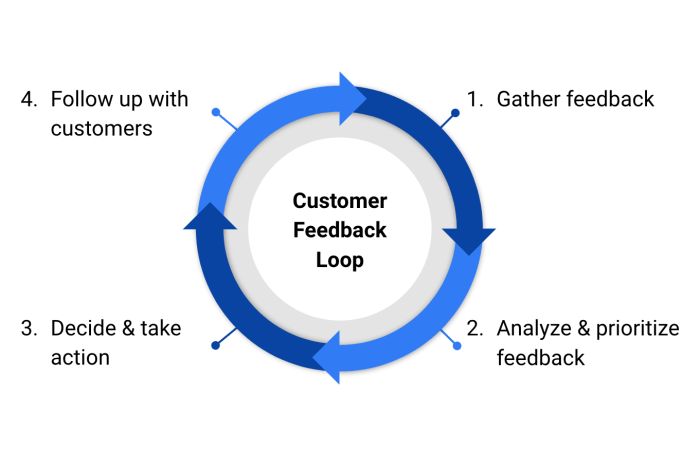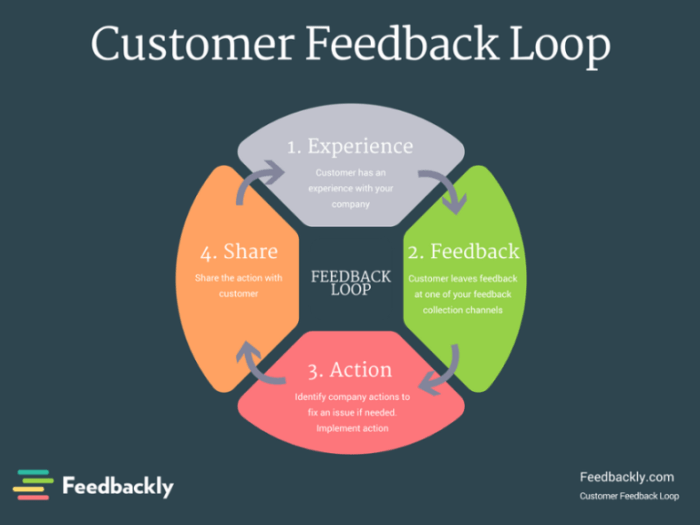Building a Customer Feedback Loop sets the stage for businesses to connect with their audience on a deeper level, harnessing valuable insights for growth and success. From understanding the essence of feedback to implementing strategic changes, this journey is all about enhancing customer experience and driving positive outcomes.
Get ready to dive into the world of customer feedback like never before, where every interaction matters and every response shapes the future of your brand.
Introduction to Customer Feedback Loop
A customer feedback loop is a process where businesses collect, analyze, and act upon feedback from their customers to improve products, services, and overall customer satisfaction.
Building a customer feedback loop is essential for businesses as it allows them to understand customer needs, preferences, and pain points. By actively seeking and listening to customer feedback, businesses can make informed decisions that lead to increased customer loyalty, retention, and ultimately, business growth.
Benefits of Implementing a Customer Feedback Loop
- Improved Customer Satisfaction: By addressing customer feedback, businesses can enhance their products and services to better meet customer needs, leading to higher satisfaction levels.
- Identifying Areas for Improvement: Customer feedback helps businesses pinpoint specific areas that need attention, allowing them to make targeted improvements.
- Enhanced Product Development: Feedback from customers can provide valuable insights for developing new products or enhancing existing ones to better align with customer expectations.
- Building Customer Loyalty: Actively engaging with customer feedback shows that businesses value their customers’ opinions, fostering trust and loyalty among customers.
- Competitive Advantage: By continuously iterating based on customer feedback, businesses can stay ahead of competitors by offering products and services that resonate with their target audience.
Setting Up a Customer Feedback System: Building A Customer Feedback Loop

Setting up a customer feedback system is crucial for businesses to gather valuable insights from their customers. It involves various key components and methods to effectively collect and analyze feedback.
Key Components of a Customer Feedback System
A customer feedback system typically consists of:
- A feedback collection method: This can include surveys, reviews, social media monitoring, comment cards, and more.
- An analysis process: After collecting feedback, businesses need to analyze the data to identify trends, patterns, and areas for improvement.
- Actionable steps: Based on the feedback received, businesses should take actionable steps to address customer concerns and improve their products or services.
- Feedback loop closure: It’s essential to close the loop by following up with customers on the actions taken in response to their feedback.
Methods for Collecting Customer Feedback
There are various methods businesses can use to collect customer feedback:
- Surveys: Sending out online or offline surveys to gather structured feedback from customers.
- Reviews: Monitoring and analyzing reviews on platforms like Yelp, Google, or social media.
- Social Media: Actively engaging with customers on social media platforms to gather real-time feedback.
- Feedback Forms: Providing feedback forms on websites or in-store to capture customer opinions.
Establishing Feedback Channels
Businesses can establish feedback channels through various means:
- Email: Sending out feedback requests via email and providing a direct channel for customers to share their thoughts.
- Website: Creating a dedicated feedback section on the website where customers can submit their feedback easily.
- In-person: Collecting feedback through face-to-face interactions, focus groups, or comment cards at physical locations.
- Phone: Setting up a hotline for customers to call and provide feedback or voice their concerns.
Analyzing Customer Feedback
Analyzing customer feedback data is a crucial step in understanding the needs and preferences of your customers. By examining the feedback received, businesses can identify trends, common issues, and areas for improvement. This valuable information can help in making informed decisions to enhance products, services, and overall customer satisfaction.
Tools and Techniques for Sentiment Analysis
- Text Analytics Tools: Utilize tools like Lexalytics or MonkeyLearn to analyze customer feedback text for sentiment, identifying positive, negative, or neutral tones.
- Social Media Listening: Monitor social media platforms to gauge customer sentiment through comments, mentions, and hashtags related to your brand.
- Surveys and Feedback Forms: Design surveys with rating scales or open-ended questions to gather structured feedback for sentiment analysis.
- Sentiment Analysis APIs: Integrate sentiment analysis APIs like IBM Watson or Google Natural Language Processing to automate the process of analyzing large volumes of feedback data.
Importance of Categorizing Feedback for Actionable Insights
Categorizing feedback into different themes or topics is essential for extracting actionable insights. By organizing feedback based on common categories, businesses can prioritize areas that require immediate attention and track progress over time. Categorization also helps in identifying recurring issues, patterns, and sentiments expressed by customers, enabling targeted strategies for improvement and enhancing overall customer experience.
Implementing Changes Based on Feedback
After analyzing customer feedback, the next crucial step is implementing changes based on the insights gained. This process involves prioritizing feedback, addressing negative feedback constructively, and making successful changes that enhance the customer experience.
Prioritizing Feedback for Implementation
When deciding which feedback to implement first, it’s essential to prioritize based on factors such as the frequency of the feedback, the impact it has on the customer experience, and how aligned it is with your business goals. By focusing on feedback that will make the most significant positive impact, you can ensure that your efforts are directed towards areas that matter most to your customers.
Addressing Negative Feedback Constructively
Negative feedback can provide valuable insights into areas that need improvement. Instead of taking negative feedback personally, view it as an opportunity to learn and grow. Respond to negative feedback with empathy, acknowledge the customer’s concerns, and communicate how you plan to address the issue. By addressing negative feedback constructively, you can turn a dissatisfied customer into a loyal advocate for your brand.
Examples of Successful Changes Made Based on Customer Feedback, Building a Customer Feedback Loop
- Implementing a live chat feature on the website after customers expressed frustration with long response times via email.
- Adding more customization options to a product based on customer requests for a personalized experience.
- Improving the checkout process by simplifying steps and adding multiple payment options following feedback about difficulties during checkout.
Monitoring and Measuring Feedback Loop Effectiveness
Customer feedback is a crucial element in improving products and services, but it’s equally important to monitor and measure the effectiveness of the feedback loop to ensure continuous improvement. By tracking key metrics and measuring customer satisfaction and loyalty through feedback, businesses can make informed decisions and implement changes that truly resonate with their target audience.
Key Metrics to Track
- Net Promoter Score (NPS): This metric measures the likelihood of customers to recommend your business to others. A higher NPS indicates greater customer satisfaction and loyalty.
- Customer Satisfaction Score (CSAT): CSAT helps measure how satisfied customers are with a specific interaction or experience. It provides valuable insights into areas that need improvement.
- Feedback Response Rate: Monitoring the percentage of customers who provide feedback can give you an idea of how engaged your customer base is and the effectiveness of your feedback collection methods.
Measuring Customer Satisfaction and Loyalty
- Surveys and Feedback Forms: Implementing regular surveys and feedback forms can help gauge customer satisfaction levels and identify areas for enhancement.
- Social Media Listening: Monitoring social media platforms for mentions, reviews, and comments can provide real-time feedback on customer sentiment and satisfaction.
- Repeat Purchase Rate: Tracking how often customers make repeat purchases can indicate their loyalty and overall satisfaction with your products or services.
Importance of Continuous Monitoring and Improvement
Continuous monitoring and improvement are essential to ensure that the feedback loop remains effective and responsive to changing customer needs and preferences. By regularly analyzing feedback data, identifying trends, and implementing necessary changes, businesses can maintain high levels of customer satisfaction, loyalty, and retention. This iterative process helps businesses stay competitive in today’s dynamic market landscape.
Engaging with Customers through Feedback

Engaging with customers during the feedback process is crucial for building strong relationships and fostering loyalty. By actively listening to their feedback, responding promptly, and implementing changes based on their suggestions, businesses can show customers that their opinions are valued. This not only helps improve products and services but also creates a sense of trust and connection with the brand.
Tips for Engaging with Customers through Feedback
- Respond promptly to feedback: Acknowledge customer comments and let them know that their feedback is being taken seriously.
- Ask for more details: Encourage customers to provide specific examples or suggestions for improvement.
- Show appreciation: Thank customers for taking the time to share their feedback, whether it’s positive or negative.
- Keep customers updated: Let them know about any changes or improvements made based on their feedback.
- Personalize interactions: Use customer names and personalize responses to show that you value their input.
Role of Customer Feedback in Building Relationships
Customer feedback plays a vital role in building relationships with customers by showing that their opinions are valued and taken into consideration. By actively engaging with customers through feedback, businesses can demonstrate their commitment to providing excellent customer service and continuously improving their offerings to meet customer needs.
Examples of Companies Excelling in Customer Engagement through Feedback
| Company | Feedback Engagement Strategy |
|---|---|
| Amazon | Amazon encourages customers to leave reviews and ratings for products, which not only helps other shoppers make informed decisions but also provides valuable feedback for the company to improve its offerings. |
| Sephora | Sephora uses customer feedback to personalize product recommendations and offers, creating a more personalized shopping experience for customers. |
| Zappos | Zappos is known for its exceptional customer service, which includes actively listening to customer feedback and going above and beyond to address customer concerns and suggestions. |
